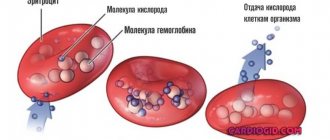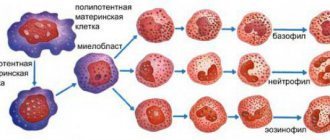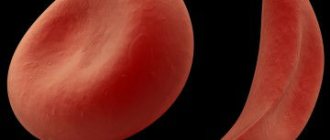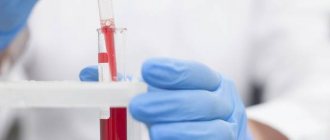Lipid metabolism is the process of accumulation, movement, and metabolism of fats. These substances are represented by a wide group of compounds. From cholesterol to triglycerides. There are more than a dozen named structures in total.
Some of them, due to their extremely small size and chemical structure, are capable of clinging to the walls of blood vessels. Attaching to the inner lining of the arteries, they gradually layer and create special formations - plaques, which impede blood flow and interfere with tissue nutrition.
The atherogenicity coefficient is one of the analyzes designed to assess the likelihood of lipid deposition on the walls of blood vessels and the risk of developing atherosclerosis.
As a rule, the index is calculated separately from the general blood test. As part of an expanded study of the body's fat spectrum. The technique is not very complicated and is highly informative.
Based on the atherogenicity coefficient, experts draw conclusions about the nature of lipid metabolism. However, all indicators need to be assessed, and in the advanced analysis there are more than 10 of them.
Based on the results, specific treatment is prescribed. Without treatment, atherosclerosis causes ischemic processes. Heart attacks, strokes and other dangerous conditions that put an end to the patient’s health.
What values are being examined?
The atherogenicity coefficient, also known as the index, is a special integral indicator that is calculated using the formula. The calculations use a group of values that doctors reflect in the analysis of the extended lipid spectrum.
Total cholesterol
A special lipophilic substance. Its chemical structure is an alcohol. Despite popular belief, this is not a harmful compound. It plays an important role, acts as a building material for the body.
Without a normal amount of cholesterol, cell membranes are not formed, adequate energy metabolism is impossible, and the process of body restoration and regeneration slows down.
General indicators reflect the approximate state of metabolism. Therefore, a simple, routine blood test is not enough. Especially if there are suspicions of pathological processes, atherosclerosis.
Low density lipoproteins
Mistakenly called "bad cholesterol". Indeed, among all lipids, LDL is one of the most dangerous and atherogenic. Exceeding the indicator always provokes serious pathologies. But by itself it cannot be called cholesterol.
This is a specific protein, a protein that performs transport functions. A product of fat metabolism, it is formed under the action of a special enzyme. It is able to bind cholesterol and then transport it throughout the body.
It is the protein + specific alcohol complex that is dangerous. Due to its extremely small size, it easily catches on the walls of arteries and forms large layers. This indicator is used as one of the main ones when calculating the atherogenic index.
Very low density lipoproteins
An intermediate product of lipolysis, the breakdown of proteins. From these, the body synthesizes LDL. This substance is not as dangerous as the previous one. However, at high concentrations it creates a risk of developing atherosclerosis.
Otherwise, the role of VLDL is positive. This is a transport specific protein. It transports cholesterol and phospholipids.
Triglycerides
Not quite fats, but rather complexes responsible for energy metabolism. They are esters. They themselves do not provoke atherosclerosis. However, an increase in TG values indicates that lipid metabolism in the body is disturbed.
This is not always the case. You need to look at other blood test indicators. Read more about the functions and norms of triglycerides in this article.
High density lipoproteins
Another substance in the fatty spectrum. However, unlike the previous ones, the effect of their presence in the body is exactly the opposite. HDL has antiatherogenic properties. That is, they reduce the risk of developing pathological processes.
Why is this happening? The fact is that the particles of this substance are extremely large and dense, so they cannot cling to the walls of blood vessels.
On the other hand, the substance has binding properties. Thanks to this, high-density lipoprotein molecules easily attach particles of fat and cholesterol as they move. And then they are taken out and disposed of.
Apolipoproteins
- Apolipoprotein A1 is a protein that plays a specific role in lipid metabolism and is also the main protein component of HDL. Activates enzymes that unload cholesterol from tissues into HDL particles and allow them to be recognized by liver receptors and bind to these receptors. Apolipoprotein A1 concentration can be measured directly and tends to fall and rise with HDL levels.
- Apolipoprotein B is the main protein in all lipoproteins, with the exception of HDL. Reflects the danger of developing atherosclerotic lesions, thus being its marker. In addition, apolipoprotein B plays a major role in the recognition and binding of LDL by special receptors located on the membranes of almost all cells of the body, in addition to red blood cells and cells of the nervous system.
Calculation formulas
The atherogenicity index (also known as coefficient) is a synthetic indicator, a mathematical model. It is calculated using several formulas.
- The simplest and most popular among laboratories is: (Total cholesterol - high-density lipoprotein)/HDL.
As a rule, all calculations are carried out automatically; they are carried out by a device that assesses the state of the blood. In some cases, the results are corrected by the doctor himself, manually.
- There is another formula: (VLDL + LDL)/HDL
There is not much difference in terms of efficiency and accuracy. It all depends on the methodology followed by a particular laboratory.
- Finally, there is a third way to calculate: (low-density lipoproteins + triglycerides)/2.2. The resulting figure is then divided by the concentration of HDL.
All three methods are equivalent. If there is any doubt about accuracy, several methods are used. This increases the information content of the study.
Triglycerides
Triglycerides are the most important source of energy for cells; they are derivatives of glycerol. Triglycerides enter the human body with food, then they are synthesized in adipose tissue, then in the liver and in the intestines. The level of triglycerides in a person’s blood directly depends on age. To diagnose atherosclerosis, as well as many other diseases, triglyceride analysis is used. Plant seeds, liver and adipose tissue contain triglycerides, which are an essential part of human food.
Norms by age
Among women
The indicator is dimensionless because it is an index, a ratio.
Levels increase with age. The phenomenon is inevitable, but no less dangerous. After 50-55 years, when menopause begins, the norm of the atherogenic index in women is in the range of 3.2-3.3.
If the level is higher than these values, in addition to standard therapy, hormonal replacement treatment is also needed.
| Age (years) | Normal indicators |
| 20-30 | Up to 2.2 |
| 31-40 | 1.8-4.4 |
| 41-60 | 3.2 |
| Over 60 years old | No more than 3.3 |
In men
| Age (years) | Meaning |
| 20-30 | Up to 2.5 |
| 31-40 | 2-4.92 |
| 41-60 | Not higher than 3.5 |
| After 60 | No more than 3.4 |
The normal atherogenic coefficient in men is in the range of 2.5 - 4.9 units. The difference is quite significant. The reason is that in a man’s body cholesterol and lipids are consumed more actively.
The standards given in the tables are approximate. It is necessary to examine other indicators in the system, and only then draw conclusions.
Complexes with this research
Male anti-aging diagnostics Monitoring of key indicators in men aged 40+ 13,300 ₽ Composition
Advanced male anti-aging diagnostics Advanced monitoring of key indicators in men aged 40+ 33,710 ₽ Composition
Women's anti-aging diagnostics Monitoring of basic blood parameters in women aged 40+ 12,070 ₽ Composition
IN OTHER COMPLEXES
- Fitness monitoring 6,780 RUR
- Metabolic profile RUB 5,900
- Lipidogram. Diagnosis of atherosclerosis 480 ₽
- Nutritionist recommends RUB 7,570
- Advanced anti-aging diagnostics in postmenopause RUB 29,230
Reasons for increasing the coefficient and methods of treatment
An increase in the atherogenic index is a typical condition and occurs frequently. There are exceptions when patients with proven atherosclerosis have normal pathology values, but this is an extremely rare occurrence. What causes the index to increase:
Poor nutrition
There are quite a lot of options. The most dangerous foods in terms of atherogenicity are those rich in various chemical additives. Synthetic origin. Semi-finished products, canned food. You should also avoid consuming fatty meats.
Otherwise, nutrition plays a rather secondary role. No matter how much cholesterol there is in a particular food, problems do not always begin. The body knows how to regulate its condition without outside help.
When pathologies develop, the atherogenicity coefficient increases, which means that there is already some kind of disorder and the body simply cannot cope with the utilization of lipids. For example, diseases of the thyroid, pancreas, etc. are often such disorders.
Treatment. It is enough to adjust your diet. It includes more fresh fruits, vegetables and plant products in general.
They completely refuse canned food and semi-finished products. Fatty meat. If necessary, it is better to discuss the issue with a nutrition specialist.
High body weight
What is the cause and what is the effect is not entirely clear. As a rule, weight increases precisely due to metabolic disorders. For the same reason, blood lipid levels change.
Accordingly, these two phenomena have the same source, but they are not related. At least in the early stages. Then the disorder of fat metabolism leads to persistent problems and it is no longer possible to reduce body weight on your own.
Treatment. Etiotropic. Oddly enough, weight loss will not be possible until the issue of weakened metabolism is resolved. This is the job of an endocrinologist. There are no universal recommendations.
Smoking
The threat lies not so much in nicotine, but in other compounds contained in tobacco products. These are cadmium, arsenic, antimony, carbon-based substances, including carbon monoxide, lead oxides and much more.
It is clear that such a “cocktail” cannot add health. Lipid metabolism is disrupted gradually. The longer the smoking experience, the worse the situation is.
Treatment. Quitting cigarettes. As a rule, in the early stages this is an effective measure. Then, if the process is advanced, special treatment will be required.
Statin drugs are prescribed, possibly medications to support the heart and brain: nootropics, cardioprotectors.
Lack of movement
Physical inactivity. Causes stagnation in the body. To accelerate lipid metabolism, normal blood flow is needed. If the patient mostly sits, and even more so is in an immobilized state, lying down, tissue trophism weakens.
The movement of blood through the vessels also becomes slow and insufficient. Hence, problems with metabolism, and as a result, an increased atherogenic index.
Treatment. It is necessary to strengthen the regime of physical activity. Walk at least an hour a day. Walking in the fresh air will be a good preventive measure.
The situation is more difficult with bedridden or paralyzed patients. In this case, light active or passive charging, with the participation of an assistant, is suitable.
If you have the desire and health allows, you can exercise more intensively. At your own discretion.
Burdened heredity
Plays almost the main role. This is a significant risk factor. Metabolic problems are usually not directly transmitted. Although there are exceptions. With genes, a person receives a predisposition. Definite risk.
With a competent approach and a careful lifestyle, there is every chance of never encountering a problem. It is likely that we are talking about a group of factors rather than one specific gene. The issue has not yet been fully studied.
Treatment. There is no therapy as such. The problem is deep, embedded in the foundation of the body. You have to deal with the symptoms.
Alcohol consumption
Alcohol, no worse than smoking, destroys the endocrine system and disrupts metabolism. The process is approximately the same as in the case of cigarettes.
Ethanol, when broken down, inhibits normal metabolism. You should not believe rumors and myths about the benefits of alcohol for metabolism. This is nothing more than fiction.
Treatment. Complete abstinence from alcohol. If you want to drink, then high-quality red wine is suitable in quantities of up to 50 ml per day. The layout is strict. As well as a recommendation for choosing a drink.
Diabetes mellitus type 2
Chronic endocrine disease. Tissue sensitivity to insulin decreases, this is the result of excess body weight. Generalized disturbances in the functioning of all body systems are typical. Metabolism also suffers.
Treatment. Diabetes itself must be eliminated. The first step is to reduce your body weight. For this, a special diet is prescribed. Statins are prescribed as needed (as a measure of prevention and correction of symptoms). Also insulin to keep blood glucose within adequate limits.
Stressful situations
They are considered more likely to be predisposing factors than to the direct causes of the increased atherogenicity coefficient. Intense mental stress causes the release of cortisol, norepinephrine, adrenal cortex substances and catecholamines. In the system, they inhibit lipid metabolism and slow down the utilization of cholesterol. What this entails is already clear.
Treatment. The goals of therapy include normalizing the psycho-emotional state, combating stress and increasing resistance to it. The issue is resolved under the supervision of a psychotherapist. Methods are appropriate.
Medicines are prescribed rarely, as needed. There is obvious pathology. For example, neurosis, anxiety disorder.
Liver diseases
They play a key role in the formation of the atherogenic index. It is here, in the body's largest laboratory, that lipids are processed.
Any disorders, even minimal ones, immediately cause deviations. Unnoticeable at first. And then objective ones. Which manifest themselves with specific symptoms.
The classic forms of disorders are hepatitis. Inflammatory processes of an infectious, less often toxic type.
Another option is cirrhosis of the liver. In the acute form, the patient has little time to understand. So does the doctor. There is no time for special in-depth diagnostics. Urgent treatment is required.
In chronic cases, experts identify a complete imbalance in all lipids. And the further it goes, the worse it gets. If the atherogenic coefficient is increased, this is a reason to first of all pay attention to the liver.
Treatment. Hepatoprotectors are prescribed. Carsil, Essentiale. Their task is to protect organ cells from destruction and help tissues regenerate. Dynamic status monitoring is shown.
A gastroenterologist works with the patient. It’s even better when you have the opportunity to consult a highly specialized doctor - a hepatologist.
Hypertension
{banner_banstat9}
Chronic disease of the cardiovascular system. Accompanied by frequent increases in blood pressure.
An increased coefficient of atherogenicity is formed as a result of impaired blood flow in the body - the vessels are spasmed and do not transport fluid tissue quickly enough. Metabolism, including lipids, also slows down.
Treatment. Specific. It is necessary to reduce blood pressure levels and return them to normal. Depending on the situation, ACE inhibitors (Perindopril, Perineva, Capoten and the like), beta blockers (Metoprolol, etc.), calcium antagonists (Diltiazem, Verapamil), sartans, and centrally acting agents are prescribed.
Also diuretics. Diuretics (Veroshpiron, Hypothiazide, Furosemide). The question is very difficult. You cannot do without consulting a cardiologist, or even more than one.
Diseases of the endocrine system
{banner_banstat10}
Other than diabetes. Thyroid disorders are dangerous. If we produce few hormones, our metabolic rate drops. Treatment. Synthetic analogues of iodine are prescribed. Replacement therapy is carried out.
When the atherogenicity index is increased, this means that there is a violation of the liver or endocrine system organs, less often an incorrect lifestyle, and the influence of bad habits.
Indications for the purpose of analysis
- Atherosclerosis and related diseases of the cardiovascular system, in particular coronary heart disease (prognosis, assessment of the risk of complications, diagnosis).
- Liver and kidney diseases.
- Endocrine pathology (hypothyroidism, diabetes mellitus).
- Screening examinations.
Preparation It is recommended to donate blood in the morning, between 8 and 11 am. Blood is drawn on an empty stomach, after 10-12 hours of fasting. It is allowed to drink water without gas and sugar. On the eve of the examination, food overload should be avoided.
Reasons for the decline
A reduced atherogenicity coefficient is a very rare phenomenon, but not dangerous; on the contrary, the risks of lipid deposition and the development of atherosclerosis are minimal.
If we talk about the reasons:
- Sports lifestyle. Or systematic physical activity at a level close to the peak of your own strength. If the patient follows nutritional recommendations, intense exercise will only be a plus. Under no circumstances should you deliberately overwork and exhaust yourself. You won't get much benefit from this.
- Systematic use of statin drugs. If a person has been undergoing treatment for a long time, there is nothing unusual in a reduced atherogenic index.
- Finally, the same thing is possible with a long-term strict diet. And not only. Supporters of a healthy lifestyle, vegetarians of various kinds are practically out of the risk zone. Because they get less cholesterol from outside.
A low atherogenic index, not reaching the average norm, is a good result, there is nothing dangerous about it. Against.
What increases cholesterol?
Increased cholesterol levels can be due to various factors. The first thing you should pay attention to is your diet
.
If a person has a slight increase in cholesterol levels, doctors usually recommend that they eat less foods high in saturated fat, but certain health problems can also contribute to high cholesterol levels. For example, chronic renal failure or decreased thyroid function. Some people may have high cholesterol levels “naturally” and be inherited. This genetic abnormality is called “ familial hypercholesterolemia
”.
When shaping your diet, you need to remember that cholesterol is found only in products of animal origin. This argument is often made in favor of a plant-based diet by vegetarians. However, this does not mean that if animal food is excluded, the rest of the diet can be uncontrolled. Food fried in vegetable oil and products containing palm oil can also have a negative effect on lipid metabolism.
Additional examinations
Studying the coefficient gives an idea of the state of lipid metabolism. As well as other indicators in an extended blood test. But to understand that violations will not be to blame.
Helpful methods needed:
- Ultrasound of the liver. Ultrasound assessment of the condition of the organ. Any deviations can be considered a likely cause of changes in the atherogenic index.
- Oral interview, medical history examination. If the perpetrators-provocateurs are subjective, this is obvious. They ask questions about lifestyle and habits. The nature of nutrition, daily activity, previous pathologies, etc. Be sure to study heredity.
- Biochemical blood test. The indicators of AST and ALT are of main interest. These are the so-called liver values. If there are no organic changes on ultrasound, it is not always normal. It may well be that the process is in its infancy. The analysis will indicate the initial stages.
- Blood test for sugar. Including a load test. Used to detect diabetes.
- Study of hormone concentrations.
- Blood pressure measurement. If necessary, daily monitoring.
The research is simple but informative.
References
- Kukharchuk, V.V., Ezhov, M.V., Sergienko, I.V. and others. Clinical recommendations of the Eurasian Association of Ardiologists (EAA) / National Society for the Study of Atherosclerosis (NOA) for the diagnosis and correction of lipid metabolism disorders for the prevention and treatment of atherosclerosis. Eurasian Journal of Cardiology, 2021. - T. 2. - P. 6-29.
- Quispe, R., Elshazly, M., Zhao, D. et al. Total cholesterol/HDL-cholesterol ratio discordance with LDL-cholesterol and non-HDL-cholesterol and incidence of atherosclerotic cardiovascular disease in primary prevention: The ARIC study. Eur J Prev Cardiol., 2021. - Vol. 27(15). - P. 1597-1605.
Methods for reducing the atherogenic index
Etiotropic therapy was discussed earlier. What to do with the atherogenic index itself? Symptomatic correction is needed.
Use special medications:
- Statins. They remove cholesterol, utilize it, and help cleanse blood vessels of plaque. Atoris, Atorvastatin and other names. The choice remains with the specialist.
- Fibrates. They are not always used. As needed and only when statins don’t work. For example, Gemfibrozil.
- A nicotinic acid. It is indispensable in the fight against some forms of hyperlipidemia.
Diet plays a huge role. It is important to completely abandon semi-finished products, canned food, questionable sausages, and fast food. Preference is given to home-cooked food. Natural products. The diet includes as many plant components as possible.
Be sure to give up bad habits. Smoking and drinking alcohol.
Forecast
Favorable in most cases if the pathology is treated from the early stages. Hereditary hyperlipidemias are less easily eliminated, but symptomatic correction is possible. Even if you have to take drugs for almost your entire life. Therefore there is no big difference.
The atherogenicity index (coefficient) is an indicator that reflects the risks of atherosclerosis, a dangerous condition when cholesterol is deposited on the walls of blood vessels and causes ischemic processes.
Based on the diagnostic results, including auxiliary methods, special treatment is prescribed. Without it, the forecasts are negative. Therefore, there is no point in delaying.
Symptoms of high cholesterol
It is possible to determine the exact level of cholesterol in the body only after an analysis, but there are symptoms that may indicate the presence of disturbances in the functioning of the body. This will not allow you to make a diagnosis, but it should be a reason to visit a lipidologist or cardiologist. Make an appointment for a preventive appointment if:
- physical activity or excessive anxiety provokes the appearance of aching pain in the chest;
- even minor physical activity causes a feeling of lack of oxygen;
- you begin to get tired faster, and fatigue is accompanied by a feeling of heaviness in the chest area;
- you often have a headache for no reason, there is noise in your ears, you feel oxygen starvation to the point of fainting.
If you notice the symptoms described, make an appointment with your doctor. It will be enough to visit a therapist so that he can conduct a preventive examination and, if necessary, refer you to other specialized specialists.
The diagnosis of atherosclerosis is difficult to make without biochemical and instrumental examination, so be prepared for the fact that you will have to undergo a series of tests. The examination usually begins with a blood test and an ECG.
. Then, depending on the results obtained, a treatment program is prescribed, if necessary. The patient’s blood is usually taken from a vein, but if a quick result is needed, it can be obtained using the express method by drawing blood from a finger. To obtain more accurate results, it is recommended to donate blood on an empty stomach.










